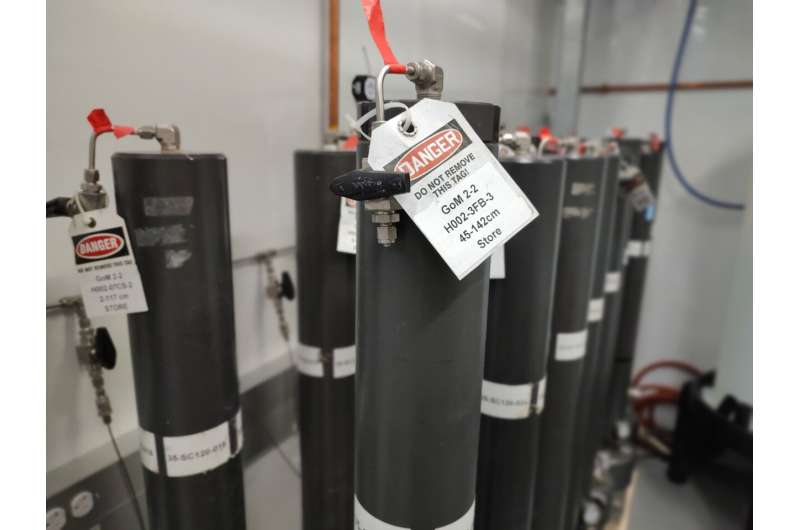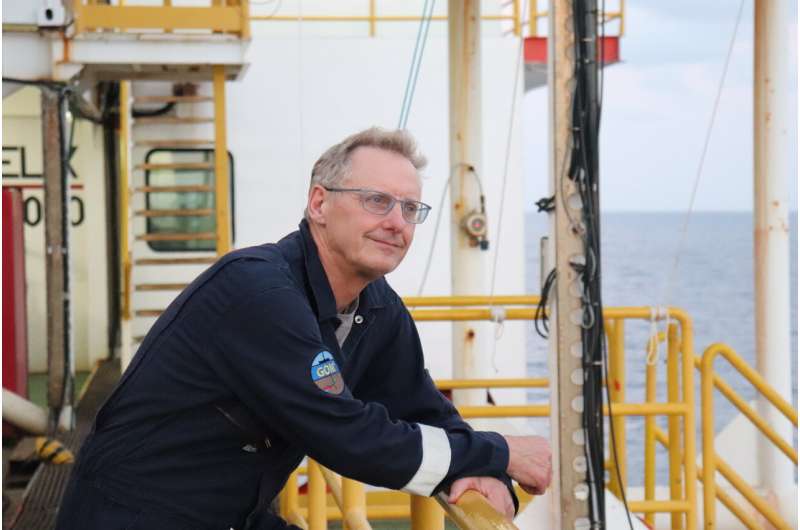This article has been reviewed according to Science X's editorial process and policies. Editors have highlighted the following attributes while ensuring the content's credibility:
fact-checked
trusted source
proofread
Scientists retrieve rare methane hydrate samples for climate and energy study

A scientific drilling mission in the Gulf of Mexico has returned with 44 cores from a methane hydrate reservoir deep under the seafloor. Globally, energy-rich methane hydrates hold an estimated 15% of the world's organic carbon but are poorly understood by the scientific community.
"This is a key part of the carbon cycle," said mission leader Peter Flemings, a professor at the University of Texas Jackson School of Geosciences. "It's a dynamic carbon reservoir that is continually emitting methane into the oceans and potentially the atmosphere."
The successful mission, led by The University of Texas at Austin, will now allow universities and scientific institutions around the country to study the methane hydrates. Chief among the research questions are how and when the hydrates formed, how they could react in a changing climate and how they could potentially be used as an energy source.
Methane hydrates are an ice-like form of methane found under high pressure and low temperatures. They are commonly formed on and under the seafloor and under arctic permafrost. However, the hydrates dissipate quickly at pressures found at the Earth's surface, which releases methane into the atmosphere. The solid hydrates are incredibly energy-dense, with each unit of methane hydrate holding 165 times the energy of an equivalent volume of gas at surface conditions. But methane is also a potent greenhouse gas, with emissions that have about 25 times the heat-trapping potential of carbon dioxide.

Hydrates are found in many part of the world. Given their potential impact on the climate and energy landscape, mission scientists said it is important to begin building a fundamental understanding of the substance, including how much methane hydrate exists.
"We have a really poor understanding of how much there is," said Ann Cook, a professor at The Ohio State University School of Earth Sciences and a scientist on the mission. "We know there's a lot, but our estimates vary by orders of magnitude."
Methane hydrate reservoirs form under the seafloor when methane collects together at low temperatures and great pressures. Understanding the specifics of the surrounding reservoir system is important because it influences whether methane hydrate stays solid or disassociates into gas, as well as how easily any free gas can leave the reservoir systems for other places—including other parts of the seafloor, the ocean and even the atmosphere. It also influences how methane hydrate could one day be produced for energy.

The mission, which took place in 2023, is part of a 10-year project. The cores have been stored at a specialized lab at the Jackson School, one of the few facilities in the world that can store and analyze hydrates under their natural pressure. Samples will be made available to other institutions. Research partners include The Ohio State University, University of Washington, Columbia University, Tufts University, Oregon State University, the James Hutton Institute, the University of New Hampshire, the Bureau of Ocean and Energy Management, and the U.S. Geological Survey.
Scientists will be studying the physical, chemical and biological properties of the substance. These include tests on the pore volume, grain size, isotopes and geochemistry of the hydrates, as well as DNA and RNA sequencing of microbes that may be present in the samples.
Provided by University of Texas at Austin


















